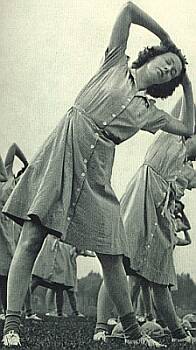At the beginning, the WAAC was expected to do four types of jobs.
The women were to be clerks, drivers, cooks and telephone operators. However,
the increased number of work fields made appropriate garments necessary.
The authorized work uniforms were the white dresses for cooks and the coveralls
for drivers only.
The service uniform could not be used for many jobs and the tight
skirt limited movements like climbing. Additionally, the uniform could
easily be ruined by dirt, grease or other substances when the women worked
in laboratories.
.
WAC Excercise Suit
.
The exercise suit was not suitable to use for work outside
the training centers. It consisted of a one-piece dress ending at knee-length
with matching bloomers. The front was buttoned down and it had a self-belt
and short sleeves. A lightweight brown and white seersucker cloth was used
as the fabric. It was worn during physical training, kitchen police, and
barrack fatigue duties to protect the service uniform. The exercise suit
could also be worn during free periods in the recreation rooms of the training
centers. However, the exercise suit with its skirt just above the knee
was inappropriate for appearance outside the WAAC area.
.
The WAC exercise suit was worn
with the WAC fatigue summer hat made of khaki cotton twill. The WAC field
shoes or the white tennis shoes (as shown in the pictures below) with socks
could be worn with the dress. The issue of tennis shoes was stopped after
a short time due to material shortage. |
.... |
|
.
 |
|
 .
Note: for more freedom of movement
the button
.
Note: for more freedom of movement
the button
closure on the front was unbuttoned
up to the waist.
|
.
The urgent request for appropriate women’s work attire (especially
trousers) was denied several times. The only concession was to issue one
fatigue coverall to all women assigned to the field (instead of two exercise
suits).
.
Herringbone Twill (HBT)
Fatigue Uniform
.
 Herringbone Twill Coverall
Herringbone Twill Coverall
|
... |
The coverall initially had been designed for jobs like tire-changing
and emergency repairs. First, a one-piece coverall was issued made of khaki
cotton jean material or olive-drab herringbone twill. Later a two-piece
olive-drab herringbone twill model, consisting of shirt and trousers was
introduced.
..
Both herringbone twill fabric variations were criticized as ill-fitting
and unbecoming clothing. On the one hand, the herringbone twill cloth was
too hot for summer wear and work in kitchens. On the other hand, it was
too thin to protect against cold winter weather. Furthermore, it was too
clumsy to be used in laboratories, too unsightly for drivers of staff cars
and too unsanitary for hospital work.
The uniform was issued in three (later four) sizes only (Small, Medium,
Large, X-Large). This caused many problems with bad fitting. It even increased
the risk of accidents.
Another problem was that the herringbone twill fatigue garments were
difficult to launder because of the weight of the material and often did
not dry over night. In addition, they tended to shrink and faded out. |
.
All in all, many complaints concerning the herringbone twill fatigue
uniform were made. It definitely proved to be a very poor substitute for
the requested special summer and winter work attire for the WAC.
.
|
|
.... |
.
|
.
Two-Piece Herringbone Twill Work Suit
.
The shirt could be worn with collar
open or closed. It had two breast pockets with flaps to button. The trousers
had adjustable button closure on each side of the waistband. WAC field
shoes with or without leggings could be worn with this work suit. Headgear
was the WAC wool knit cap, fatigue hat or steel helmet. |
|
.
WAC in full field equipment
wearing the two-piece HBT work suit
with M-1 steel helmet, WAC field shoes with leggings, canvas field bag
held with M-1936 suspenders and field bag carrying strap, M-1936 pistol
belt, canteen, and gas-mask carrier. |
.
WAC (Tropical) Summer Work
Uniform
.
A few months before the end of war, the often-required appropriate
work uniforms with trousers were finally approved. The slacks suit was
similar in design and material to the one issued Army men. The summer work
uniform consisted of khaki cotton cloth and the winter work garments were
made of wool. However, the authorization came too late in the war to have
any effect for the WAC personnel.
.
WAC Summer Work Uniform
made of cotton khaki cloth. It
could be worn with a matching garrison cap (like shown on the photo). The
summer work uniform should replace the herringbone twill work clothing
especially in tropical areas. |
.... |
|
.
ETO Uniform
.
The only WAC members who received appropriate
fatigue uniforms during the war were the ones who served within the European
Theater of Operations (ETO). They were issued a special ETO uniform during
the winter of 1944 that was well suited for field work and usual service
duty. It consisted of an English-style wool battle jacket that could be
worn with matching skirt or trousers, depending on the circumstances.
.
(more information/pictures under
"WAC
Service and Dress Uniform: ETO Service Uniform")
|
.
WAC Hospital Dress
.
|
|
... |
In January 1945, the WAC hospital dress was standardized
as special garment to wear for hospital or dental work.
Before, WACs also had to deal with several unsatisfactory substitutes
like many WAC members in other work fields.
.
The WAC, Dress, Hospital
was made of tan lightweight cotton
material with buttoned down front and detachable belt. Furthermore, the
short-sleeved dress has one breast pocket and two big patch pockets with
sufficient capacity for a work garment of this nature. |
.
. |
